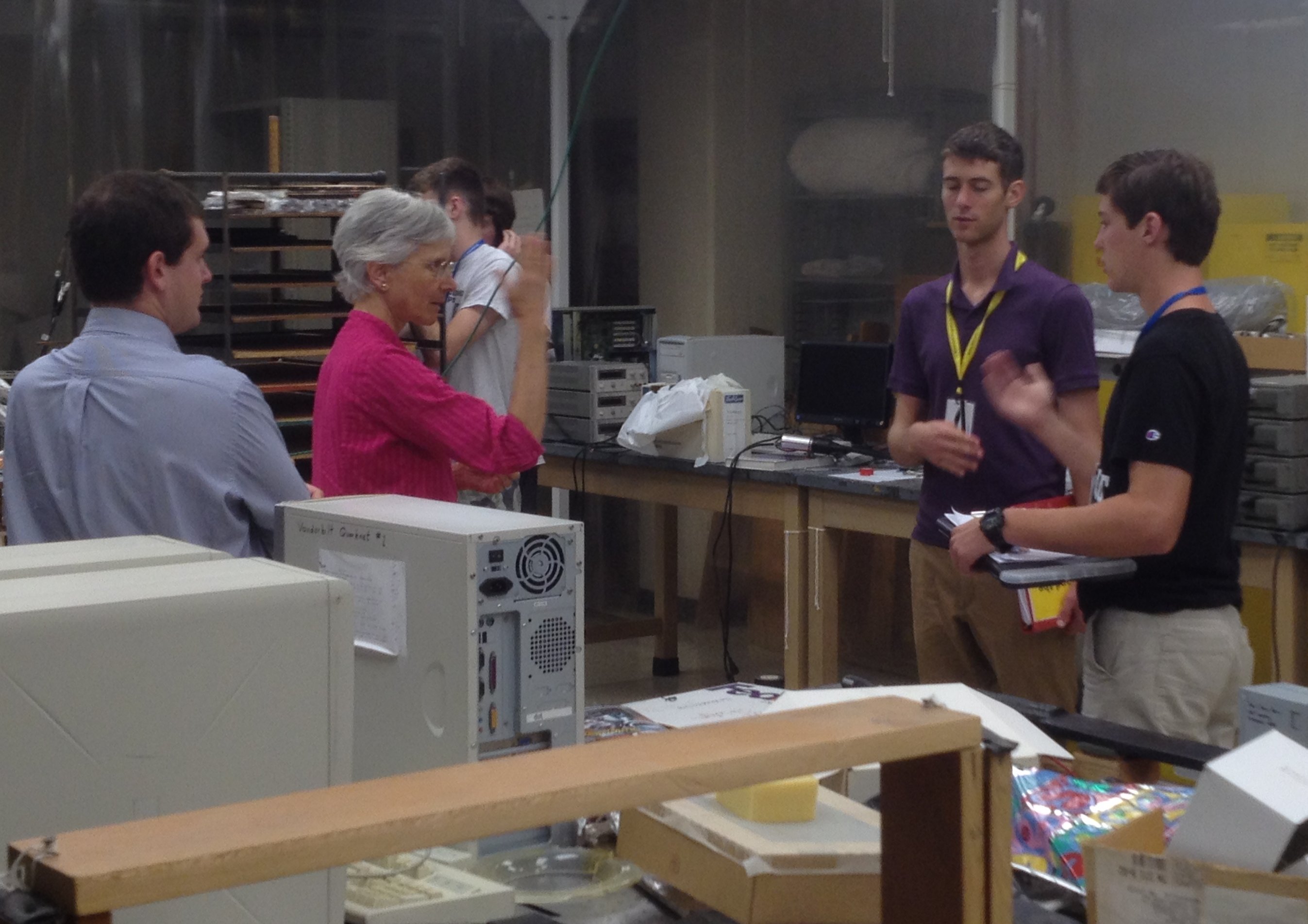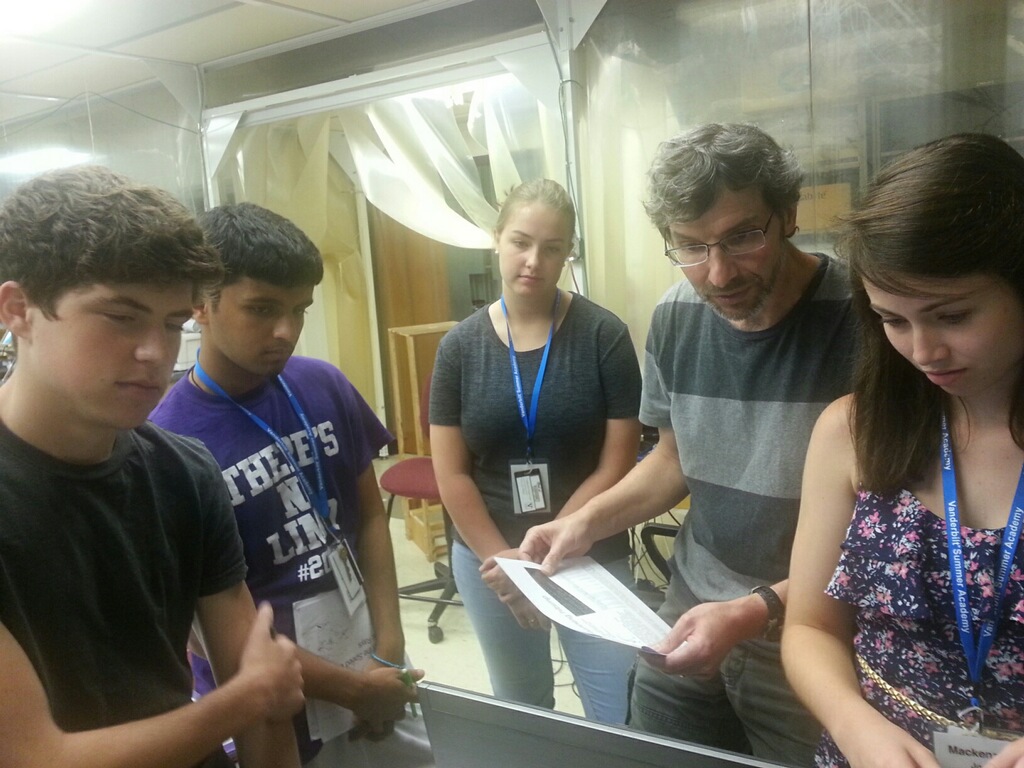2015 Annual Report - Vanderbilt University
The Vanderbilt University QuarkNet program continues to loan any offour cosmic ray muon detectors (CRMDs) and to support the use of CRMDs in the classroom for many high school teachers in the Middle Tennessee region, including Bowling Green, Kentucky. Dr. William Gabella is the mentor, with much aid and support from Dr. Med Webster, the emeritus mentor, and from Terry King, a part-time college and high school physics teacher who recently retired after 30 years experience teaching physics full-time at the high school level.
In 2015, we continued our summer workshop as a scaled-down effort (without travel) focused mostly on the CRMDs, with enrichment in particle physics, astronomy, and astrophysics, and usually some slightly out-of-the-box fun event. The previous year we toured several venues in Middle Tennessee that would be useful for teachers to know about for field trips, enrichment, and science fair ideas for their classrooms. And in 2015, we hosted a summer class of very bright high school students and discussed cosmic rays and the CRMDs and took the students through a speed-of-muons experiment.
In 2014, two of our QuarkNet teachers received their own CRMDs. For the Vanderbilt University QuarkNet program this was novel. This continued in 2015 with two more of our teachers receiving permanent CRMDs for their high schools. This gives the area 7 standard CRMDs, as well as the one with smaller scintillators best used for attenuation experiments.
Also in early 2015, Dr. Gabella was able to arrange for Vanderbilt University to kindly permanently loan the program 4 older, retired laptops. They were in decent condition, but with their hard drives completely wiped. Dr. Gabella installed Fedora Linux on them, Sun Java, and the drivers to run the EQUIP data acquisition and control program. The laptops made moving the CRMDs around much easier, replacing much older, even vintage, desktop computers. Though the OS is Linux, it has tools that look a lot like those on Windows machines that high school students have the greatest familiarity. Also the laptops' desktops were setup identically to each other, and to have icons for the usual programs: running EQUIP, file browsing to the EQUIP data directory, and to Firefox and Google Chrome browsers.
This also was a solution to the problem of trying to install the necessary drivers and software on high school computers which are usually centrally administered with teachers having very little, or no, privilege on them. It also showed that a free OS can be used with older computer platforms with modern Sun Java to run EQUIP.
Dr. Gabella also has the LabVIEW source code for the LabVIEW acquisition and control program, but has not made it work in a robust way with modern LabVIEW (version 2014) and under Linux. Though this should be possible. The LabVIEW program developed by University of Washington, has some useful graphic indicators and the ability to save the timing data in spreadsheet form.
Some minor problems with the CRMDs have come up, a bad photomultiplier tube in one case, a bad GPS in another. Dr. Webster has been indispensable in diagnosing these hardware issues and Dave Hoppert at Fermilab has been very good and timely at helping us fix these problems.
In 2014-15, we loaned out the detectors to three schools which typically will keep the CRMDs for many months or a whole semester. This allows the teacher time to remember the CRMD operation, and to demonstrate and then cycle through students running the detectors. This last semester, with so many detectors both at Vanderbilt University and in the schools, Ms. Rossberg at mcGavock High School asked for two detectors and had received one for her and her students to build. This creates a novel, for us at least, pedagogy of her having access to enough CRMDs to run them in parallel with many more students at once. We believe this is a good way to use the detectors in schools, and look forward to hearing the results.
We expect more use of the CRMDs in the coming years. We have added two new teachers to our group in existing schools, and another teacher who was active in the Purdue QuarkNet group has moved into the region. We also have several teachers that are interested in the program, but unable to participate fully. We try to enourage, educate, and support them as much as we are able.
During our QuarkNet week this year, we hosted nine teachers for some part of the week, and on Thursday we hosted 11 high school students from a summer program on Cosmology and Large Scale Structure. We had our usual half day of enrichment talks from a Andres Delannoy, particle physics graduate student, and Dr. Rudy Montez, post-doc in astronomy, as well as Dr. Gabella giving the QuarkNet News, and remembering Tom Jordan, and the CMS and LHC updates. The Monday afternoon was spent reviewing Cosmic Rays and the CRMDs and running a quick speed-of-muon experiment---in preparation for hosting the high school students on Thursday.
Tuesday and Wednesday of our week we spent with Bob Peterson. As always, it was good, informative, useful to see him again. He focused on CRMDs in shower mode and the eLab interface, which is not a strong skill in our group.
Thursday we hosted the high school students. Their numbers were small enough that we formed four teams of 3 to 4 students with one CRMD and two teachers. The main goal, or at least the stated goal, was to guide the students through the speed-of-muon experiment analyzing the data offline, using spreadsheets. The speed-of-muon experiment has he all important swapping of the two main detectors to account for the systematic effects of signal timing in the different channels. The students certainly understood that v=D/T, the velocity is the distance between the detectors divided by the time it took the particle to cross. It was a bit of a challenge for them to do the analysis on one set of data and not see a velocity that makes any sense, though sometimes it can be close to the speed-of-light. It is only after using the swapped dataset and the adding the timing together in a certain way that intrinsic timing differences cancel and the speed calculations were usually within 3% of the speed-of-light.
After introducing Cosmic Rays (their instructor Dr. Erika Grundstrom make it part of her lesson plan that week before we met them, using Cosmic Extremes and other materials) and the CRMDs to the students, we tried hard to make the students handle the detector pieces, and run the EQUIP program. We moved files around using Google Docs or thumb drives. The analysis was, for most, done in the Google Docs Sheet program. The students have little or no experience with spreadsheet programs, so that was a challenge but also added to the utility for the students. They also learn very fast and only simple functions are needed. Though many did follow the recipe to make histograms---not so easy in a spreadsheet program.

All-in-all, we thought introducing young students to the mix was quite a good experience, but the QuarkNet teachers, mentors, and the students. We all had fun and it is good to be confronted with those excellent questions from the students. Also the teachers being in a mentor-ing role, similar to, but different than their usual high school experience was a positive. Bob Peterson has mentioned that some QuarkNet groups have as many high school students as teachers during their QuarkNet week. We definitely see the benefit in that.

Friday morning we wrapped up, summarizing the Thursday activity in a document, filling out the survey for QuarkNet teachers, and cleaning up from the Thursday activity. In the afternoon, Dr. Sourish Dutta, and theorist and also our dem
In an effort to try to increase the student enthusiasm, beyond a hard-core number, Dr. Gabella started a Facebook group page for the Vanderbilt University QuarkNet group. Our thinking is that as students do interesting things with the CRMDs they can post, and show off to their friends and family, and maybe eventually to other QuarkNet students around the US and the world. The first challenge is that most teachers do not use Facebook, so it was suggested they create an account just for their science class in high school and not put personal items on it. It remains to be seen if this experiment in social media really works out, but it is a good start.
We have had a good year in the Vanderbilt University QuarkNet group. The slight increase in new people, and more importantly the increase in permanent CRMD setups, are both expected to increase the use and utility of the detectors. The group remains pretty tight and mutually supportive. With Dr. Webster's continued activity and with Mr. Terry King's support, this activity is both manageable and fun.
Facebook Vanderbilt University QuarkNet group page
https://www.facebook.com/groups/682323215235912/
Vanderbilt University QuarkNet self-hosted page
http://www.hep.vanderbilt.edu/~gabellwe/qnweb/
